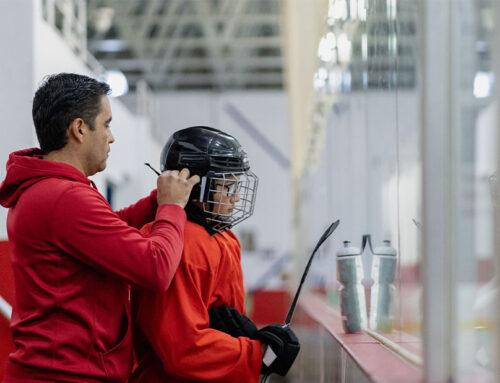How to Run a Perfect 40-Yard Dash
NFL prospects are put through a battery of tests at the Scouting Combine. However, the 40-Yard Dash is the highlight of the event, because it’s a true measure of explosive speed and overall athleticism.
Although the 40 may look simple to the untrained eye, it’s an incredibly complex test with four distinct phases. Athletes spend hundreds of hours refining every nuance of their technique to shave even a tenth of a second off their time, but such a small improvement can be the difference between catching a coach’s attention or blending in with the pack.
Improve your 40 time by refining your technique in each phase of the test.
1. Starting Position
Your body position at the start has a direct impact on the amount of force you’re able to put into the ground and, consequently, how fast you can accelerate.
- Place lead foot four inches behind starting line and trail foot two feet behind starting line
- Position trail hand on starting line with lead hand on knee
- Slowly lift hips and balance weight on supporting arm, keeping knees bent
- Raise lead leg hand straight up and behind body; focus eyes on ground
2. Acceleration Phase
This phase, which occurs in the first 10 to 12 yards, is where the most time is lost due to technique errors. Your speed is created by forcefully driving into the ground to lengthen your stride and covering as much ground as possible with each stride. To achieve speed, you must propel yourself forward rather than immediately standing up into the sprinting position. Forcefully pump your arms with each stride, keeping your elbows at a 90-degree angle. Focus your eyes a few feet in front of you on the ground.
3. Transition Phase
The transition phase runs from the end of the acceleration phase to the 20- to 30-yard mark. As you come out of the acceleration phase, assume a more upright position with each stride. You can boost your speed by increasing both stride length and frequency. Avoid the common mistake of staying in the acceleration phase too long and then popping up into the top speed phase.
4. Top Speed
At the 30-yard mark, your goal is to attain your top speed. At this point, you should be fully upright with your eyes focused straight ahead. Forcefully pump your arms with each stride. Your arm pump rate directly impacts your stride frequency. Try to cover as much ground as possible with each stride.
Improve 40-Yard Dash with even more tips.
Source: Baggett, K. “Evaluating the 40 yard dash – Part II.” Retrieved from Higher-faster-sports.com.
Photo: online.wsj.com
Kermit Cannon is the owner of Youth Sports Training and the author of The Beast Factory, a nutrition and fitness book for athletes. For 19 years, he has been a strength and conditioning coach for Santa Monica High School, where he has trained hundreds of individuals and several championship teams. Many of his athletes have received college scholarships or have entered the professional ranks. Cannon is a member of the National Federation of State High School Associations, Let’s Move!, the National Council of Youth Sports, the Sports Youth & Marketing Network and USA Track & Field. In 2011, he received the Community Leadership Award from the President’s Council on Fitness, Sports & Nutrition.
RECOMMENDED FOR YOU
MOST POPULAR
How to Run a Perfect 40-Yard Dash
NFL prospects are put through a battery of tests at the Scouting Combine. However, the 40-Yard Dash is the highlight of the event, because it’s a true measure of explosive speed and overall athleticism.
Although the 40 may look simple to the untrained eye, it’s an incredibly complex test with four distinct phases. Athletes spend hundreds of hours refining every nuance of their technique to shave even a tenth of a second off their time, but such a small improvement can be the difference between catching a coach’s attention or blending in with the pack.
Improve your 40 time by refining your technique in each phase of the test.
1. Starting Position
Your body position at the start has a direct impact on the amount of force you’re able to put into the ground and, consequently, how fast you can accelerate.
- Place lead foot four inches behind starting line and trail foot two feet behind starting line
- Position trail hand on starting line with lead hand on knee
- Slowly lift hips and balance weight on supporting arm, keeping knees bent
- Raise lead leg hand straight up and behind body; focus eyes on ground
2. Acceleration Phase
This phase, which occurs in the first 10 to 12 yards, is where the most time is lost due to technique errors. Your speed is created by forcefully driving into the ground to lengthen your stride and covering as much ground as possible with each stride. To achieve speed, you must propel yourself forward rather than immediately standing up into the sprinting position. Forcefully pump your arms with each stride, keeping your elbows at a 90-degree angle. Focus your eyes a few feet in front of you on the ground.
3. Transition Phase
The transition phase runs from the end of the acceleration phase to the 20- to 30-yard mark. As you come out of the acceleration phase, assume a more upright position with each stride. You can boost your speed by increasing both stride length and frequency. Avoid the common mistake of staying in the acceleration phase too long and then popping up into the top speed phase.
4. Top Speed
At the 30-yard mark, your goal is to attain your top speed. At this point, you should be fully upright with your eyes focused straight ahead. Forcefully pump your arms with each stride. Your arm pump rate directly impacts your stride frequency. Try to cover as much ground as possible with each stride.
Improve 40-Yard Dash with even more tips.
Source: Baggett, K. “Evaluating the 40 yard dash – Part II.” Retrieved from Higher-faster-sports.com.
Photo: online.wsj.com
Kermit Cannon is the owner of Youth Sports Training and the author of The Beast Factory, a nutrition and fitness book for athletes. For 19 years, he has been a strength and conditioning coach for Santa Monica High School, where he has trained hundreds of individuals and several championship teams. Many of his athletes have received college scholarships or have entered the professional ranks. Cannon is a member of the National Federation of State High School Associations, Let’s Move!, the National Council of Youth Sports, the Sports Youth & Marketing Network and USA Track & Field. In 2011, he received the Community Leadership Award from the President’s Council on Fitness, Sports & Nutrition.











